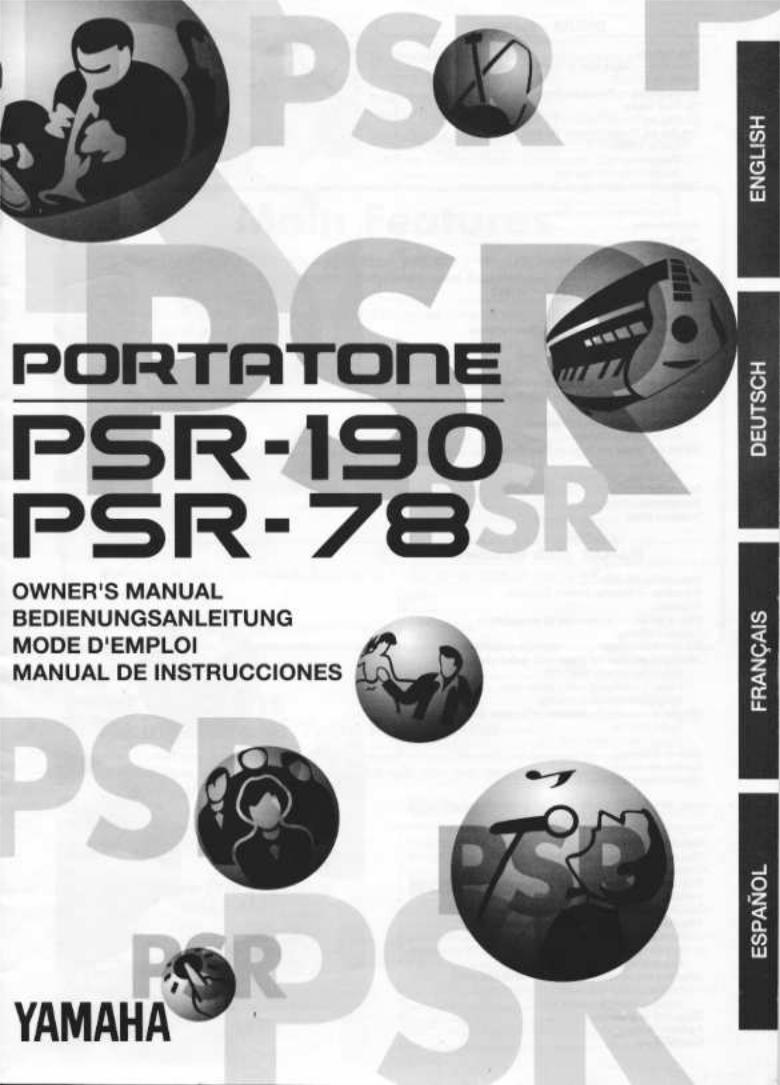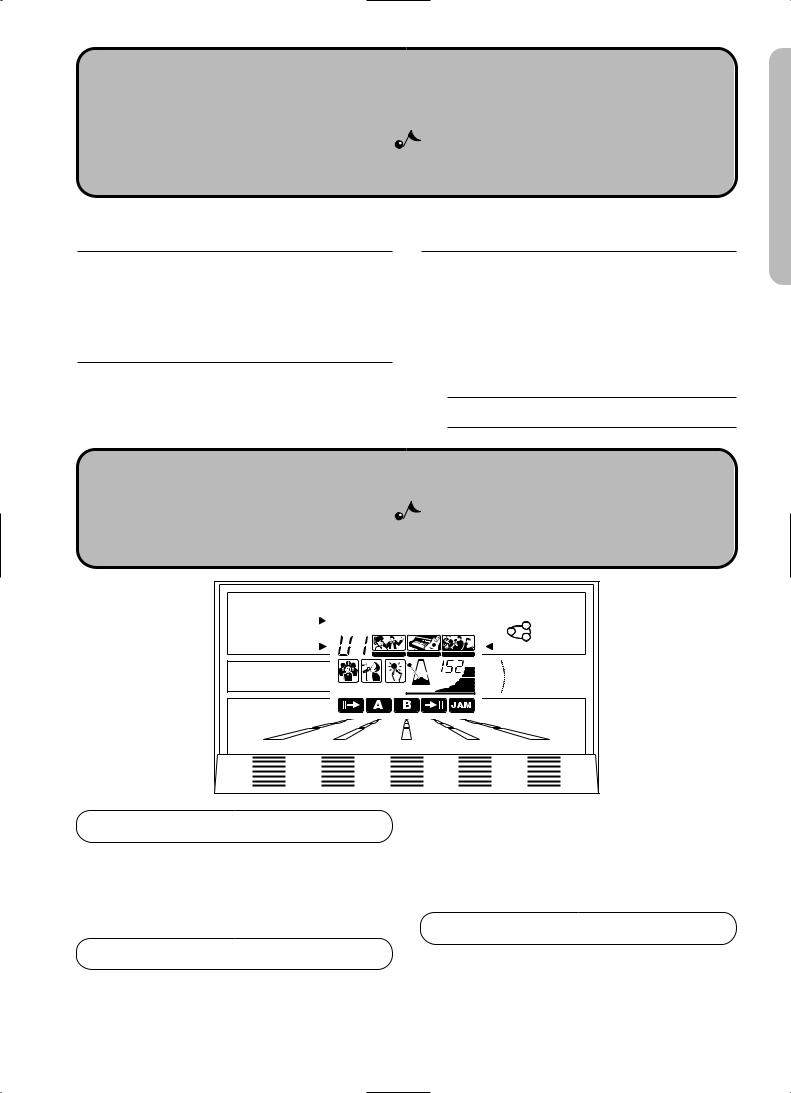Yamaha Audio PSR-78, PSR-190 User Manual

Downloaded from: http://www.usersmanualguide.com/

ENGLISH Ð Contents |
|
Main Features .............................................................................................. |
1 |
Precautions Ñ Taking Care of Your PortaTone....................................... |
1 |
Setting Up..................................................................................................... |
2 |
Getting Started Ñ Playing the Demo Songs ........................................... |
3 |
The Panel Display ........................................................................................ |
3 |
Selecting and Playing Voices Ñ The Voice Mode ................................... |
4 |
Selecting and Playing Styles Ñ The Style Mode .................................... |
5 |
About the METRONOME Icon ........................................................................ |
6 |
About Multi Fingering .................................................................................. |
8 |
One Touch Setting in the Style Mode............................................................. |
9 |
Selecting and Playing Songs Ñ The Song Mode ..................................... |
9 |
Minus One .............................................................................................. |
10 |
One Touch Setting in the Song Mode........................................................... |
10 |
Troubleshooting ......................................................................................... |
10 |
Song Scores ................................................................................................ |
11 |
Specifications.............................................................................................. |
21 |
DEUTSCH Ð Inhalt |
|
Hauptmerkmale............................................................................................ |
1 |
Vorsichtsma§nahmen Ñ Behandlung Ihres PortaTone........................... |
1 |
Vorbereitung des Instruments ................................................................... |
2 |
Fangen wir an Ñ Spielen der Demo-Songs.............................................. |
3 |
Anzeigefeld................................................................................................... |
3 |
Einstellen und Spielen von Klangfarben Ñ Voice-Modus....................... |
4 |
WŠhlen und Spielen von Styles Ñ Style-Modus..................................... |
5 |
Hinweise zum METRONOME-Icon .................................................................. |
6 |
Hinweise zur Multi-Fingering-Begleitautomatik ................................................ |
8 |
One Touch Setting im Style-Modus ................................................................ |
9 |
WŠhlen und Spielen von Songs Ñ Song-Modus...................................... |
9 |
Minus One............................................................................................... |
10 |
One Touch Setting im Song-Modus.............................................................. |
10 |
Fehlersuche ................................................................................................. |
10 |
DemonstrationsstŸcke............................................................................... |
11 |
Technische Daten........................................................................................ |
21 |
FRAN‚AIS Ð Table des mati•res |
|
ParticularitŽs principales............................................................................. |
1 |
PrŽcautions Ñ Entretien de votre PortaTone.......................................... |
1 |
PrŽparatifs ................................................................................................... |
2 |
Mise en marche Ñ Les morceaux de dŽmonstration .............................. |
3 |
Panneau d'affichage .................................................................................... |
3 |
SŽlection et exŽcution des sonoritŽs Ñ Le mode Voice ......................... |
4 |
SŽlection et exŽcution des styles Ñ Le mode Style ............................... |
5 |
Quelques mots sur l'ic™ne METRONOME......................................................... |
6 |
A propos du Multi-fingering (mode ˆ plusieurs doigts) ...................................... |
8 |
RŽglage par touche unique en mode Style...................................................... |
9 |
SŽlection et exŽcution des morceaux Ñ Le mode Song ......................... |
9 |
Fonction Minus One ................................................................................. |
10 |
RŽglage par touche unique en mode Song.................................................... |
10 |
Guide de dŽpannage .................................................................................. |
10 |
Partition des oeuvres................................................................................ |
11 |
CaractŽristiques techniques ...................................................................... |
21 |
ESPA„OL Ð êndice |
|
Caracter’sticas principales .......................................................................... |
1 |
Precauciones Ñ Cuidado del PortaTone ................................................... |
1 |
Preparativos................................................................................................. |
2 |
Para empezar Ñ Reproducci—n de canciones de demostraci—n ............. |
3 |
Pantalla......................................................................................................... |
3 |
Selecci—n y reproducci—n de voces Ñ Modalidad VOICE ........................ |
4 |
Selecci—n y reproducci—n de estilos Ñ Modalidad STYLE ....................... |
5 |
Indicaciones del icono del metr—nomo ........................................................... |
6 |
Digitaci—n mœltiple ...................................................................................... |
8 |
Ajuste de un toque en modalidad STYLE......................................................... |
9 |
Selecci—n y reproducci—n de canciones Ñ Modalidad SONG .................. |
9 |
Funci—n Menos Uno ................................................................................. |
10 |
Ajuste de un toque en la modalidad SONG ................................................... |
10 |
Diagn—stico de problemas......................................................................... |
10 |
Partituras de canciones ............................................................................. |
11 |
Especificaciones .......................................................................................... |
21 |

Congratulationsr t l ti
on yourr purchaserc off thet Yamaha PortaTone!rt !
You now own a portable keyboard that combines advanced functions, great sound and exceptional ease-of-use in a highly compact package. Its outstanding features also make it an remarkably expressive and versatile instrument.
Read this Owner’s Manual carefully while playing your new PortaTone in order to take full advantage of its various features.
Main Features
The PortaTone is a sophisticated yet easy-to-use keyboard with the following features and functions:
●Exceptionally realistic sounds with 100 AWM (Advanced Wave Memory) Voices, utilizing digital recordings of actual instruments.
●100 dynamic auto accompaniment Styles, each with different Intro, Main A and B, four Fill-ins, and Ending sections. Each of the 100 Styles also has its own Jam Track section, featuring specially programmed chord progressions and accompaniment that matches the selected musical Style.
●Large custom LCD gives you easy, at-a-glance confirmation of all important settings.
●Convenient control over accompaniment Styles — including Tempo, independent Accompaniment Volume, and even accompaniment “size” (LARGE/SMALL control).
●20 Songs, for listening enjoyment or for playing along with when using the Minus One function.
●One Touch Setting, for automatically calling up an appropriate Voice for playing with the Style or Song you select.
●High-quality amplifier/speaker system (stereo for the PSR-190).
Precautions
Ñ Taking Care of Your PortaTone
Your new PortaTone is a fine musical instrument Ñ and should be treated as such. Handle it with care and common sense, and it will give you years of enjoyment.
■ Location
• Avoid exposure to direct sunlight or other sources of heat. Never leave it inside a car where it can get very hot. Also avoid highly humid or dusty places.
■ Interference From
Electromagnetic Fields
• Do not use your PortaTone close to television sets, radios or similar equipment since this may cause interference noise in the other appliance.
■ Handling
• Protect your PortaTone from strong impact. Be careful not to drop it or place heavy objects on it. Avoid applying excessive force to the controls and keys.
■When Not Using the PortaTone
• After use, always turn off the POWER switch. When not using your PortaTone for long periods, be sure to remove the batteries to avoid damage through battery leakage. When using the PortaTone with an AC adaptor, unplug the adaptor from the electrical outlet, if the instrument is not to be used for a long period of time, or during electrical storms.
■Cleaning
•Clean the exterior with a soft, dry cloth. To remove stubborn stains, use a slightly moistened cloth.
•Never use alcohol, thinner, or other chemical solvents, since they will damage the finish. Also, do not leave vinyl chloride material on the PortaTone for a long time, since it may adhere to the exterior.

 Yamaha is not responsible for damage caused by improper usage.
Yamaha is not responsible for damage caused by improper usage.
1

Setting Up
This section contains information about setting up your PortaTone for playing. Make sure to read this section carefully before using the instrument.
Power Requirements |
■ |
When the Batteries Run Down |
Your PortaTone can run either on batteries (sold separately) or on normal household current by using the optional Yamaha PA-3/3B Power Adaptor (or another adaptor specifically recommended by Yamaha).
Using an AC Power Adaptor
To connect your PortaTone to a wall socket, you will need the optionally available Yamaha PA-3/3B Power Adaptor. Use of other AC adaptors could result in damage to the instrument, so be sure to ask for the right kind. Plug the adaptor into a convenient wall outlet and its connector into the DC IN 10-12V jack on the back of your PortaTone.
DC IN 10-12V
Using Batteries
■ Inserting Batteries
Turn the instrument upside-down and remove the battery compartment lid. Insert six 1.5-volt size “D” batteries as shown in the illustration, making sure that the positive and negative terminals are properly aligned, and replace the lid.
When the batteries run low and the battery voltage drops below a certain level, the PortaTone may not sound or function properly or may be reset to the default status. As soon as this happens, replace them with a complete set of six new batteries. Never mix old and new batteries or different types of batteries (e.g., alkaline and manganese).

 To prevent possible damage from battery leakage, remove the batteries from the instrument if it is not to be used for an extended period of time.
To prevent possible damage from battery leakage, remove the batteries from the instrument if it is not to be used for an extended period of time.
Accessory Jack
■ Using Headphones
For private practicing and playing without disturbing others, connect a set of stereo headphones to the rear panel PHONES /AUX OUT jack. Sound from the built-in speaker system is automatically cut off when you insert a headphone plug into this jack.
PHONES /
AUX OUT
■ Connecting a Keyboard Amplifier or
Stereo System
Though the PortaTone is equipped with a built-in speaker system, you can also play it through an external amplifier/speaker system. First, make sure the PortaTone and any external devices are turned off, then connect one end of a stereo audio cable to the LINE IN or AUX IN jack(s) of the other device and the other end to the rear panel PHONES/AUX OUT jack on the PortaTone.
Music Stand
Insert the bottom edge of the included music stand into the slot located at the top rear of the PortaTone control panel.
2

Getting Started Ñ
Playing the Demo Songs
The PortaTone has a variety of Demo Songs, specially recorded to showcase the dynamic sounds and rhythms and give you an idea of what you can do with the instrument.
1. First, turn on the power.
Press the POWER ON/OFF button. Whenever the power is turned on, the Voice mode is automatically called up and set to play Voice 01 (PIANO).
3. Press the DEMO button.
The Demo Songs will play from the Song number 01 in sequence. You can play along on the keyboard with the Songs. (Scores for the Demo Songs are provided on pages 11~20)
2. Set the Volume.
Initially, turn the VOLUME control about a third of the way up. You can adjust the control for optimum level once you start playing.
To stop playback, press the DEMO button again or press the START/STOP button.

 The Style section and the accompaniment LARGE/SMALL will change according to the Style data while the Demo Song plays.
The Style section and the accompaniment LARGE/SMALL will change according to the Style data while the Demo Song plays.
The Panel Display
The PortaTone features a large multi-function display that shows all important settings for the instrument. The section below briefly explains the various icons and indications in the display.
MODE SECTION |
|
|
|
|
|
|
|
NAME••••• |
Piano |
|
|
||||
NUMBER |
|
|
|
|
|
••••• MODE |
|
|
|
|
|
STYLE |
VOICE |
SONG |
|
SETTING SECTION |
|
|
|
|
|
MAX |
|
|
|
|
|
|
|
|
|
|
|
|
|
|
|
TEMPO |
ACCOMP VOL |
|
|
LARGE |
MINUS |
OTS |
|
MIN |
|
|
|
/SMALL |
ONE |
|
|
||
|
|
|
|
|
|||
STYLE SECTION |
|
|
|
|
|
|
|
INTRO |
MAIN A |
|
MAIN B |
ENDING |
JAM TRACK |
||
MODE SECTION
This section indicates which mode is selected — Voice, Style, or Song — and shows the name and number of the selected Voice/Style/Song. To select the desired mode, press the corresponding button: VOICE, STYLE, or SONG.
SETTING SECTION
This section indicates important settings related to the Style and/or Song modes. These include LARGE/SMALL (page 7), MINUS ONE (page 10), OTS (One Touch Setting; page 9, 10), TEMPO (page 6), and Accompaniment Volume (page 7).
To turn the Large/Small, Minus One, and One Touch Setting functions on/off, press the corresponding button: LARGE/SMALL , MINUS ONE, or OTS. To control Tempo and Accompaniment Volume, use the TEMPO and ACCOMP VOL controls, respectively.
STYLE SECTION
This indicates playback of the Styles, or the rhythm/accompaniment patterns. Each Style has different “sections” — Intro, Main A and B, 4 Fill-ins, Ending, and Jam Track — each of which is indicated in the display as it plays. These can be played by pressing the appropriate button during accompaniment playback. (See page 6, 7)
3
